Shore Mate! Thing
By Nick Jones
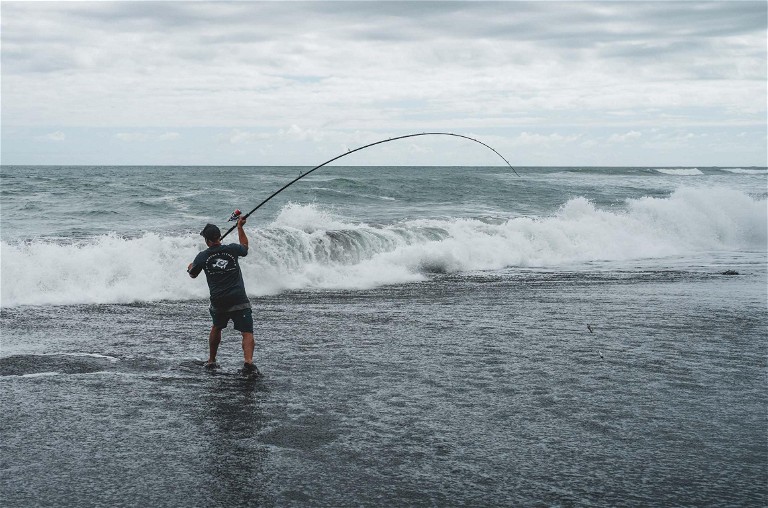
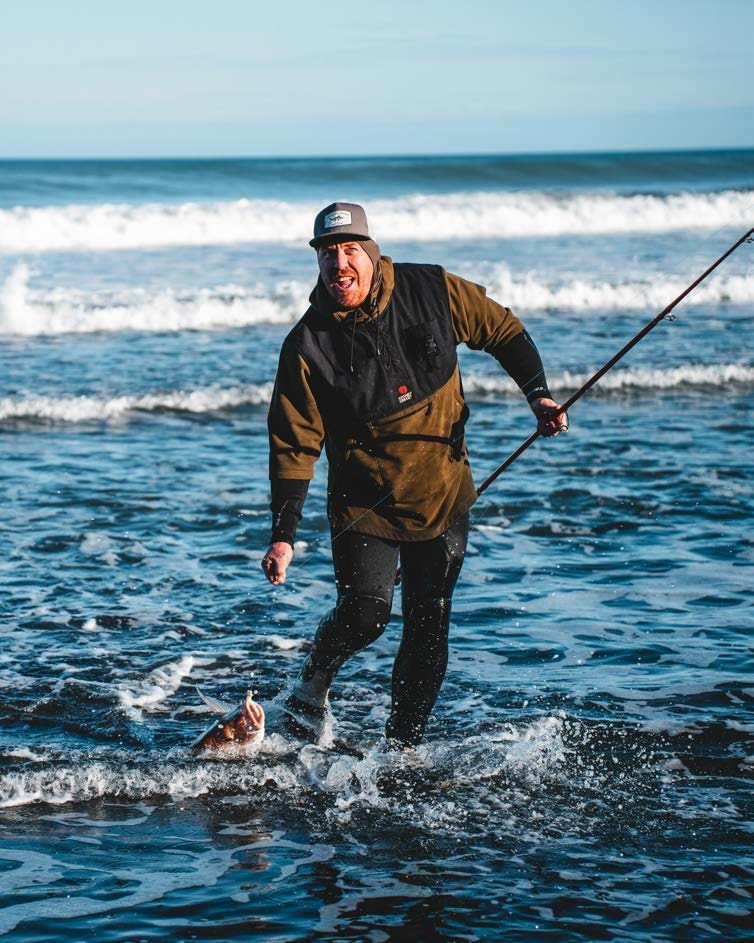
Many popular fish species venture close to shore around our fine country during summer. nd what better holiday activity than fooling a few tasty specimens while at the beach with the family or, for the more adventurous, bushwhacking and scrambling your way to a precipitous oceanic ledge in pursuit of a trophy?
While landbased angling is rarely a shooting fish in a barrel’ kind of affair, it is an e tremely satisfying and enjoyable form of wetting a line. ere are a fewpointers to help stack the odds in your favour and make bringing home the goods a shore thing pun intended.
GEARING UP
They say good builders never blame their tools, but that’s probably because good builders have good tools The same concept applies to fishing, and luckily, it’s a pretty small investment to gear up to cast a line from the shore.
When surfcasting from the beach or shallower rocky ledges, casting distance is normally important. That’s where long rods - ’ come in handy, and they also allow your line to stay above some of the breakers when your baits are out. Specialised surfcasting reels feature large diameter spools which also ma imise distance, but any large spin reel will do the job fine. I like to use a simple asher or ledger rig off the beach with a breakout sinker that holds in the sand. een surfcasters often use long cast rigs that incorporate a pulley and clip-down feature designed to give e tra casting distances. Theother crucial bit of kit is a rod spike and a deck chair so you can sit down and enjoy the fishing hands-free
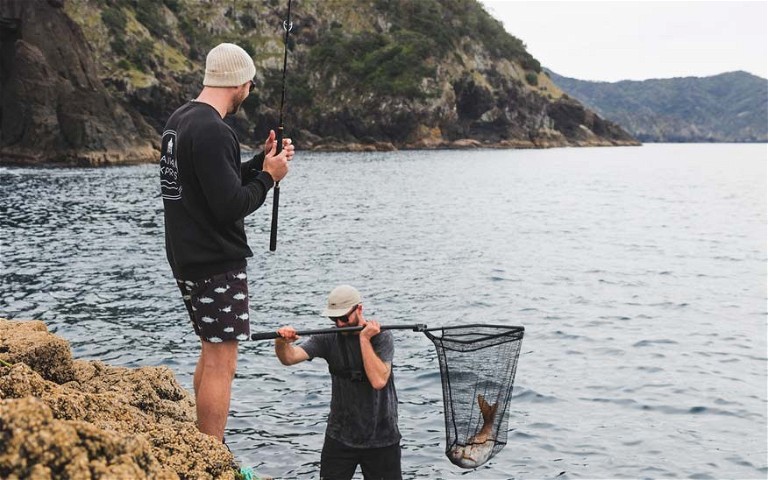
Nevertheless, arguably the most rela ing and effective method of fishing from the beach is to use a drone or electric kontiki to take multiple baits out beyond the surf zone work smarter, not harder mate In all cases, baits should be firm think fresh kahawai or frozen mullet or you can use softer baits like pilchard or shellfish and wrap them onto the hook with bait cotton. Shellfish baits are particularly effective on blue moki and trevally.
For rockfishing off ledges with access to deeper water, a variety of fishing techni ues can be applied. ishing unweighted baits into a big berley trail is a tried-and-true method for catching big snapper, trevally, kahawai and kingfish off the bricks. baitrunner-style reel matched with an rod is perfect for this. The more berley the merrier, and often on more remote spots, you’ll have fish swimming around right at your feet munching on your tasty ansel and Gretel trail.
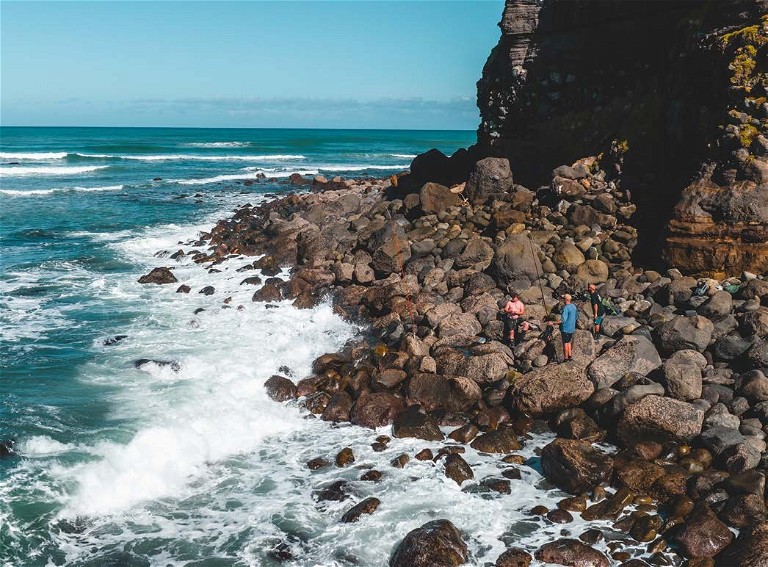
If you’re into lure fishing, then softbaits and topwater lures like poppers and stickbaits can be employed very effectively too. or softbaiting from shore, aim for a set that’s heavier and longer than your standard snapper softbait set for the boat. onger rods give you better casting ability and help keep your line away from the rocks, and heavier mainline gives you more insurance in gnarly terrain. I’d recommend using a -size reel that’s capable of holding a few hundred metres of - lb braid, - lb uorocarbon trace, and an ft or longer rod rated at - kg.
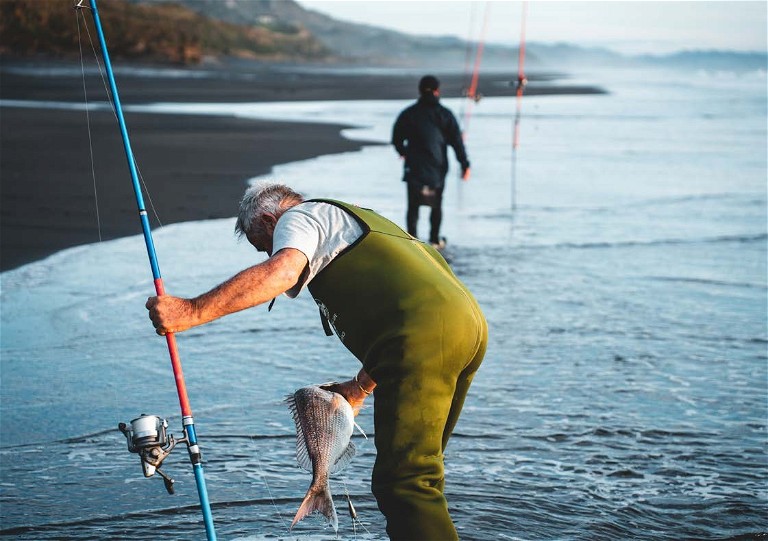
The same applies for topwater sets err on the heavier side of the ledger as it can be uite a battle pulling kingfish away from gnarly, rocky terrain. nd last but certainly not least make sure you pack a decent pair of polarised goggles. enses specifically designed for shallow water or trout anglers really come into their own for not only identifying fish swimming below, but also seeing when a fish is homing in on your bait or lure.
PICKING YOUR SPOT
Fortunately, we are surrounded by coastline here in otearoa, so the shore fishing opportunities are pretty much endless. West coast beaches are prone to big waves, but when conditions allow they offer some e ceptional fishing. Ideally, you want to be landing your baits in deeper gutters and channels that sit between the banks and sandbars along surf beaches. ote thatthese shift greatly depending on the stage of the tide.
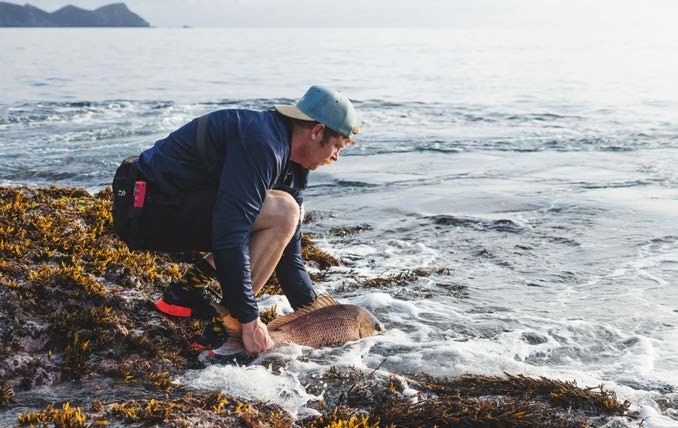
On the east coast, generally the more remote beaches such as those in the Far North, East Cape, Hawkes Bay and Wairarapa offer the best fishing. In saying that, however, I’ve had some nice hauls of snapper around Auckland’s inner-city beaches, so you can’t write off any spot until you’ve tried it!
Similarly, the prime rockfishing spots tend to be remote ledges that offer depth, current and decent water clarity. Think Northland, Coromandel, East Cape, and offshore islands such as Great Barrier. These areas are definitely where you want to head if you’re after consistent year-round trophy snapper and kingfish action. Google Earth is a great tool to scope out rocky areas that have a lot of foul close to deep water or current. A bit of wash tends to help your chances and having the wind behind your back makes casting and seeing fish a breeze.
However, there are many more accessible locations that produce desirable species like kingfish and john dory – especially during the warmer months. Harbour entrances, breakwalls, and wharves where baitfish congregate are all worth a crack.
TURNING THE ODDS IN YOUR FAVOUR
Dawn and dusk are many anglers’ favourite times to drop a line, and it is widely regarded that fish feed hard as the sun is rising or going down. This is especially so with respect to landbased fishing, as fish use the cover of darkness to hunt the shallows. Fish like snapper can be notoriously tricky to tempt during the middle of the day in summer; the fish are there, but they can be hard to catch. Early morning and evening are also a good time to catch livebaits, and predatory fish like kingies tend to use shallow light angles to their advantage, busting up hapless baitfish in the morning and evening.
I’ve mentioned it previously, but at the risk of sounding like a broken record, I’ll stress again that berley can be a real game-changer off the rocks. Unlike boat anglers who can drift or change spots regularly to cover ground, landbased folk are confined to their chosen ledge. So, it makes sense to bring the fish to you with an oily attractant. A variety of NZ species became aggressive and cocky when you berley up a storm from the rocks – and watching big snapper, trevally and kingfish cruising around literally at your feet certainly gets the knees a bit weak! Salmon burley is excellent with its high oil content.
“ Ideally, you want to be landing your baits in deeper gutters and channels that sit between the banks and sandbars along surf beaches. ”
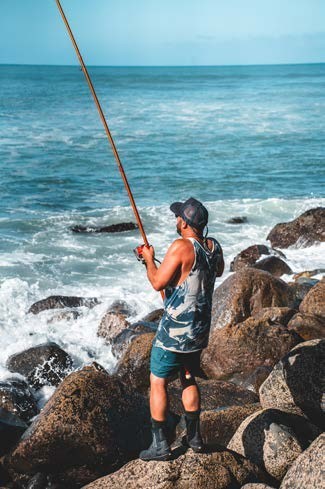
Another secret weapon is taking the time to catch a few livebaits like mackerel, mullet, piper or kahawai. It’s no surprise that predatory fish often want to eat the real deal, and you can look like a superhero when you hookup to a big john dory or kingfish down at the local wharf! The other bonus is that any livebait you nab can be repurposed as fresh cut or whole bait to target other desirable species like gurnard and snapper – you beauty!
Good luck with your landbased summer fishing adventures.